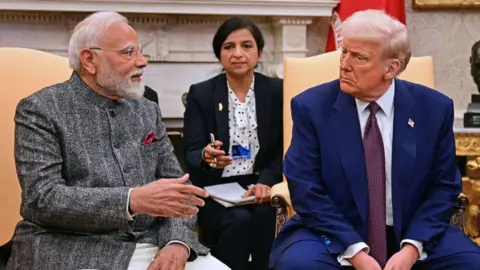U.S. President Donald Trump announced a 25% tariff on goods from India, citing high Indian tariffs and New Delhi’s continued purchases of Russian oil and military equipment.
Speaking on Truth Social, Trump described India as a “friend,” but argued that it maintains “tariffs far too high” on US exports. Alongside the 25% duty, he plans to introduce a new import “penalty” targeting nations that maintain economic ties with Russia, beginning this Friday.
“Remember, while India is our friend, we have, over the years, done relatively little business with them because their Tariffs are far too high, among the highest in the World, and they have the most strenuous and obnoxious non-monetary Trade Barriers of any Country,” Trump wrote on Truth Social.
“Also, they have always bought a vast majority of their military equipment from Russia, and are Russia’s largest buyer of ENERGY, along with China, at a time when everyone wants Russia to STOP THE KILLING IN UKRAINE — ALL THINGS NOT GOOD!” he continued.
The penalty comes as part of a wider tariff overhaul that Trump’s campaign says is meant to punish countries that “enable” the war in Ukraine through continued commerce with Moscow. India, a key buyer of Russian crude and arms, has not joined Western sanctions against Russia since the conflict began.
India’s close historical ties with Russia, along with its stance of strategic neutrality, have made it a growing concern for Washington’s foreign policy establishment.
Trade Imbalance Adds Fuel to the Fire
Trump also pointed to the U.S.-India trade imbalance, which reached $45.8 billion last year, according to the U.S. Census Bureau. India exported more to the U.S. than it imported, with key categories including pharmaceuticals, auto parts, jewelry, and electronics.
At a population of over 1.4 billion, India is the world’s most populous country and a potential economic counterweight to China — a fact that further complicates U.S. policy.
Exporters Face Uncertainty on Both Sides
The tariff announcement has already begun disrupting business planning. U.S. buyers are holding off on new orders amid uncertainty over what rates will ultimately apply. Meanwhile, Indian exporters rushed to ship goods earlier this year, but future demand — especially for the lucrative Fall-Winter season — is now in limbo.
The pain could extend beyond the U.S. market. Indian exporters are also struggling in Europe, where they face increasing competition from discounted Chinese goods redirected from the U.S. after China’s own tariff battles intensified.
Brics Penalty Could Further Shrink India’s Edge
India’s position may become even more precarious if Trump follows through with an additional 10% tariff on countries that continue buying Russian oil — a penalty aimed squarely at Brics nations. Such a move would sharply erode India’s price advantage and make it harder for its exports to stay competitive in the global market.
Compared to other major U.S. partners, such as Japan, the EU, Indonesia, and the Philippines, India could end up facing a disproportionately steep tariff burden if both the 25% base duty and Brics-related penalty are enforced.
With elections looming in both countries, the coming months could shape the trajectory of US-India trade for years to come. India’s exporters, already squeezed by global inflation and logistical bottlenecks, now face a major new variable: geopolitics.
For consumers, companies, and policymakers alike, the message is clear — tariffs may once again become a key tool in shaping international relationships, especially in a world where alliances are constantly being redefined.






